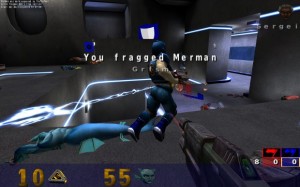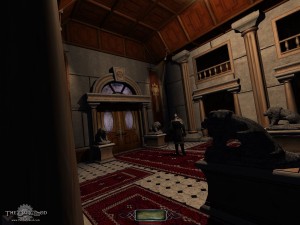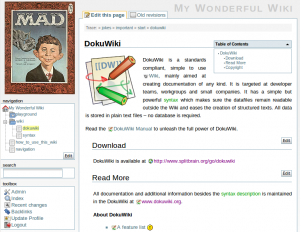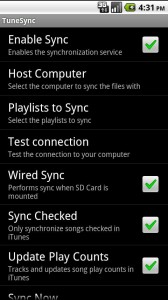Game week : “Open Arena” Cross platform Quake3 Fun !
Jan 28If I say the word “Rocketjump” and you have no idea what it is ? … Then you seriously need to read the next post. In day two of our cross-platform gaming week we point you toward the reincarnation of one of the best first person shooters ever created. We are talking about Quake 3. A fantastic, high speed, fast moving, addictive, life-eating, relationship-destroying, girlfriend-infuriating game that kept us ALL up till dawn back in the year 2000. Quake is one of those “shoot anyone that moves” games that had a massive online following. No matter what part of the world you were at, there was always a server where you could log into and fire frag and respawn to your hearts desire.
I remember fondly how I would “get rid of my girlfriend” by taking her home at ten .. coming back to my apartment and start playing Quake 3 till 4am while eating Nacho’s and drinking coke. Quake is fun, addictive and has eaten a big part of my life I can never get back. And i had such a good time… I don’t even care 🙂
Now you (and your cross platform buddies) can have a go with “Open Arena” a free, open-source and cross platform friendly port of the old Quake game. It might not be as fancy as your newest Xbox one game, but EVERY first person shooter is in some way or form a descendant ( I feel the urge to say “Derivative”) of the original Quake 3.
Feed your dog for the next three weeks and kiss your job goodbye. Download and play Open Arena .. for free HERE.
Related Posts
Game week : The Dark Mod : Cross platform first person “Sniper”.
Jan 27I am old. It is a shocking statement, but there are some facts that back up that statement. For one : I am absolutely terrible with console games. My fingers turn to putty whenever I need to press the right combination of buttons on my controller. I either turn ‘Need for Speed’ into a farming simulator (trying to plow a field with my 500 million dollar Bentley) or turn ‘Call of Duty’ into a charity game by giving my enemies my rations in the heat of battle. ( Army food is a lethal weapon .. right ? ).
But with age comes a certain kind of grace : the ability to completely own & pown when you can get your hands on a keyboard and a mouse. From a very young age I was trained by master-gamers in the secrets of Doom, Quake and Counter Strike. The latter proved to be something I was very good at. I was a lethal opponent in stealth and my sniper rifle killed more men then I fired bullets. Yes .. I was a camper .. but a damn good one. Mock me and you will look over your shoulder for the rest of your life. I was ‘death invisible’.
Since stealth and secrecy so becomes me, I found ‘THE DARK MOD” a great game to play. Based on the Doom engine, the goal of the game is to sneak around, kill your enemies and try not to make a sound. Hiding the body prevents tripping off the alarms, Lurking in the shadows means opponents can’t see you … Using knives instead of guns helps you go unnoticed. I love it.
The Dark Mod is gloomy, has atmosphere and is pretty addictive to play. The great part is that this game is available on both Windows, Mac and Linux and it is for free.
Get your copy of “The Dark Mod” here.
Related Posts
kw708 : Android Essentials.
Dec 31We close up 2013 AND season 7 of the Knightwise.com podcast with out Android Essentials list for 2013. Whether you have an Android Smartphone, Tablet or Mediasystem, this is the list you can’t afford to miss. Check out our selection of cross-platform friendly Android apps and enjoy some cool photography tips from Konrad Dwojak in the feedback section. Packed to the rafters its KW708.
Shownotes.
- Show : Curating the library of your mind.
- Application list
- Google Calendar
- Any.do
- Evernote
- Pomodoro
- Chrome
- Feedly
- Tweetcaster
- Google+
- If this then that (Service)
- Facebook Messenger
- Androirc
- Voxer
- Google Hangouts
- Skype (not mentioned in the podcast)
- Runkeeper
- Weather Apps
- IMDB app
- Wikipedia App
- Shazaam
- Tripadvisor
- Svoice
- Google Now ( List of Google Now commands )
- Connectbot
- ES File explorer
- Dropbox
- Teamviewer
- Google Drive
- Aldiko
- Archos video player (and Codec Pack)
- Vlc
- Tunesync
- Stitcher
- Swiftkey
- Xbmc
- Plex
- Sonos
- Photo tips from Konrad.
Related Posts
Docuwiki : Take notes everywhere … seriously … every-where !
Nov 21Greetings blog readers! It is I, Matt, the stay-at-home g33kdad in Northern California. I am writing today to discuss a topic that has been much on my mind lately and that is “note taking”. I know, Y A W N, right? Who cares? You open a google doc, you jot some stuff down… or maybe I used a MS word doc for that… where did I save that again… is it in Evernote… oh, here’s some paper, i’ll just write it down… but, then I’ll just have to type it up later… and what if I want to work on it at my mom’s house…and if it’s stored on some company’s server somewhere, what kind of privacy is there… nevermind, I’ll just play xbox.
So, in the spirit of T. S. Eliot who wrote that immature poets copy while mature poets steal, I steal this from Allison Sheridan of the Nosillacast Podcast, “What is the problem to be solved?”
The problem, as I see it, is keeping track of information digitally (whether or not the information started out digital). Now, unless you have been living under a rock for the recent past, you probably have an opinion on “cloud” services and computing. There are many different services available. The ubiquitous choice seems to be Evernote. Evernote is a service that allows you to store your notes on an internet accessible server. This gives you access to them from anywhere you have an internet connection. There are apps for all the major mobile platforms and for most desktop operating systems. This is a very full-featured service and very powerful, as well.
Another option is to use Google Docs or another hosted word processor. This is a great option because the interface is similar to MS Word or other word processing programs and most of the formatting options you would have on the desktop are available in your web browser.
While these are good options, they have some flaws. They require a third-party to host your notes. Having someone else handle the server maintenance and software is great, but you have to deal with privacy concerns. You also have to deal with connectivity to that service. What if you have an internet outage or you find yourself somewhere without wifi. (Do you go places without wifi?) How do you add, edit, or read notes? Also, some services may not be designed for robust note-taking.
When it comes to third-party, cloud services, my personal feelings are these: 1. Any technology can be used to make my life better. 2. Any technology I don’t own or control can be used to make my life worse. So I have to make a choice. Do I want the convenience of a service designed to meet the need? Do I want to keep all my notes in plain text on my personal computer? Is there another choice?
I have decided that a wiki is a very flexible platform for what I want to do. In case you don’t know, a wiki (see: http://www.wikipedia.org/wiki/
There are some caveats to this. Wiki software is a web app that runs (in most cases) on a webserver. So you need to have access to a webserver to utilize a wiki. This can be a shared hosting account, a vps, or a small server in your home. The requirements are minimal. In some cases, wikis can be complicated to set up.
So, what do I do? I use a package called DokuWiki. DokuWiki is related to MediaWiki which is the software that powers one of the most famous wikis in the world, wikipedia.org. It is a powerful package and works great for note-taking. There are many plugins available to change the syntax, provide for different content types and many other extensions. I have installed it on my home server and use it most every day for my needs. But there was a slight hiccup. I still needed internet access to make notes. Not a big deal when I’m on my home network, but even with dynamic DNS, I won’t have access if I can’t get to the internet. Then, I discovered the “killer app”. There is a plugin called sync (http://www.dokuwiki.org/
I have just scratched the surface of the possibilities of using DokuWiki for online note-taking. There are so many other uses for a wiki and I know that DokuWiki is so easy to deploy, I will be using it again.
Thanks for taking the time to read this article. More to come!
You can find more of Matt online at @sahgeekdad on twitter or via g33kdad.thestrangeland.net
Related Posts
Sync all your iTunes playlists to your Android phone with Tunesync
Jul 30The thing with proprietary software solutions, is that they are great. Everything tends to work smoothly together right up to the point where you decide to wander off the beaten path of supplier XYZ. A couple of years ago I made the crucial mistake of pouring my entire music collection into iTunes. Now, some 10 000 songs later .. its still in there. Being totally OCD I have organized all my tracks into nice little playlists and enjoy my tunes in the “Apple walled garden”. Whether I am playing them from the Mac, sharing out the iTunes library over iTunes to my other macs, blasting them from the Airport express speakers or syncing them to my other i-Devices.
But a couple of weeks ago I could not help myself myself and crawled over the walled garden into android territory with my purchase of a Galaxy Note 2. And accessing my delicately curated iTunes library from THIS device turns out to be an near impossible task. The deep crevasse that divides me from listening to my tunes on my “droid” consists of an incompatibility to sync with iTunes (only IOS devices of course) and the total inability to get the music on my Android in an organised form. Sure I can browse the filestructure of my iTunes library and copy over files to the SD card on my Phone .. but iTunes has “reorganized” my music into folders according to artist .. not according to playlist.
Enter Tunesync. A two-part application app in the android store that saves the day. The deal is simple. Download the server part of their app and install it on your Mac that is running iTunes. Download the CLIENT side of their application and install that to your Android device. Make sure both are on the same wifi network and be amazed !
Tunesync detected my (massive) iTunes library and started indexing the playlists right away. After I selected the playlists I wanted to have on my Android it started to copy over the tracks AND the playlist order in my Androids music collection. 20 minutes later I had all the grooves I needed on my Note2. Tunesync regularly “checks” if the playlists are still up to date and “updates” them whenever I connect or start up the app. I had expected some glitches and on one occasion Tunesync had given me all my playlists .. with no tracks inside ( it erases and re-copies all the tracks on every sync instead of doing an incremental) but when I retried the sync it worked flawlessly.
Tunesync does one thing and it does it well, and the hilarious part is , it does it better then Apples iTunes-IOS wireless sync ! The app is 4.99 in the Play store and worth every dime.
Tunesync is available from the Play Store.









